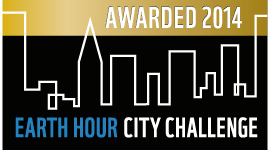Chicago green roofs
Posted on March, 01 2012
Green roofs remediate heat island effect
Green roofs remediate heat island effect
Chicago is one of the leading cities for green roofs, with 450 buildings using the technique. In the new, ambitious climate plan from 2008, the city plans to lay 6,000 green roofs by 2020. City authorities hope in this way to combat the urban heat island effect, which Chicago has severe problems with. It is also an adaptation to climate change, which is expected to include more serious heat waves.
Keywords: green roof, climate plans, urban heat island, tree planting, environmental renovation
Chicago has already distinguished itself for its work with green urban development. In the 1990s, a new programme called CitySpace began to cultivate many of Chicago’s thousands of vacant lots, in cooperation with NGOs and neighbourhood organisations. In the recent 15 years, the city has planted 500,000 trees and increased tree-covered area by 3,500 hectares.
Leader for green roofs
Chicago has become best known for its work with green roofs. When Mayor Richard Daley in 2001 decided to place a green roof on Chicago’s City Hall, there were only two companies in the US that could do the job. Since then, Chicago has become a leader in the US for green roofs, with installations on 450 buildings and over 20 Chicago-based companies with expertise.
Chicago has mapped the hottest areas of the city with infra-red cameras. A measurement in 2007 showed the effectiveness of green roofs: while the City Hall’s roof registered only 21C, the temperature on a neighbouring roof was 40C.
Green roofs have several environmentally friendly functions (see also Malmö). They clean and retain rainwater, provide insulation, improve air quality, and reduce the urban heat island effect, which is a phenomenon whereby a city is hotter than its surroundings because of heat absorption. Green roofs save energy by reducing the need for both heating and cooling. They can be implemented in all climates, on all types of buildings, even single-family housing, and work best with native plantings.
The Climate Action Plan
The success with green roofs led the city to expand the programme. In the new Chicago Climate Action Plan from 2008, the city sets the goal of 6,000 green roofs by 2020. The climate plan is one of the most ambitious and detailed in the US, and has become a model for similar plans in other American cities (see also New York and Vienna). The overarching goal is a 25% reduction of greenhouse gas emissions by 2020 compared to 1990 levels and an 80% reduction by 2050. The plan contains detailed programmes for increased energy efficiency of buildings (responsible for 70% of emissions), efforts for renewable energy sources, development of public transport, and reduction of wastes and pollution.
In a status report from 2010, Chicago showed its commitment to the plan. During the first two years, some 456 initiatives had been developed in 16 departments and sister organisations, with 13,341 housing units and 393 office buildings renovated. More than 30,000 domestic appliances had been replaced, public transport had increased by 20 million trips per year, 132 million litres of water had been saved per day, 200,000 sq.m. of green roof had been implemented, 120 green streets had been planted, 636 new vehicles had been added to car-sharing services, 208 new hybrid buses had been added, and an 83% recycling rate had been achieved in the construction sector.
Green Office Challenge
Since the start of the plan, the number of annual residential retrofits has grown 12-fold, to circa 8,000 per year. The Green Office Challenge has engaged hundreds of participants in the campaign to increase the energy efficiency of offices, with such success that the idea has been exported to other cities. A programme for installing visible water-metres is expected to reduce the use of water by at least 72% per consumer. And the 500,000 trees that have been planted in the recent 15 years are to be followed up with an equal number of additional trees before 2020.
References
”Chicago City Profile”, Smarter Cities, A Project of the Natural Resources Defense Council (NRDC), 2011, http://smartercities.nrdc.org/city-stories/city-profiles/large/chicago-illinois#tk-city-profile
City of Chicago, 2008, Chicago Climate Action Plan, http://www.chicagoclimateaction.org/filebin/pdf/finalreport/CCAPREPORTFINALv2.pdf
City of Chicago, 2010, Chicago Climate Action Plan: Progress Report, First Two Years, http://www.chicagoclimateaction.org/filebin/pdf/CCAPProgressReportv3.pdf
”Save energy and reduce stormwater runoff. Install a green roof.”, Smarter Living, NRDC, September 2009, http://www.simplesteps.org/mmm/save-energy-reduce-stormwater-runoff-install-green-roof
”Chicago: Green roofs cut energy bills”, Sustainable Cities, 2009, http://sustainablecities.dk/en/city-projects/cases/chicago-green-roofs-cut-energy-bills
Karen Alebon, Heather Kepran, Jennifer Lee, Community-Managed Open Space, ICLEI Case Study No 61 - Chicago, August 2001, http://www.iclei.org/fileadmin/user_upload/documents/Global/case_studies/ICLEI_Case_Study_Chicago_61_August_2001.pdf
Green Roof – Augustenborgs Botanical Roof Garden, What is a Green Roof?, http://www.greenroof.se/?pid=19
Key data are retrieved from the UN World Urbanization Prospects: The 2011 Revision, http://esa.un.org/unup/unup/index_panel2.html
Text by: Martin Jacobson





